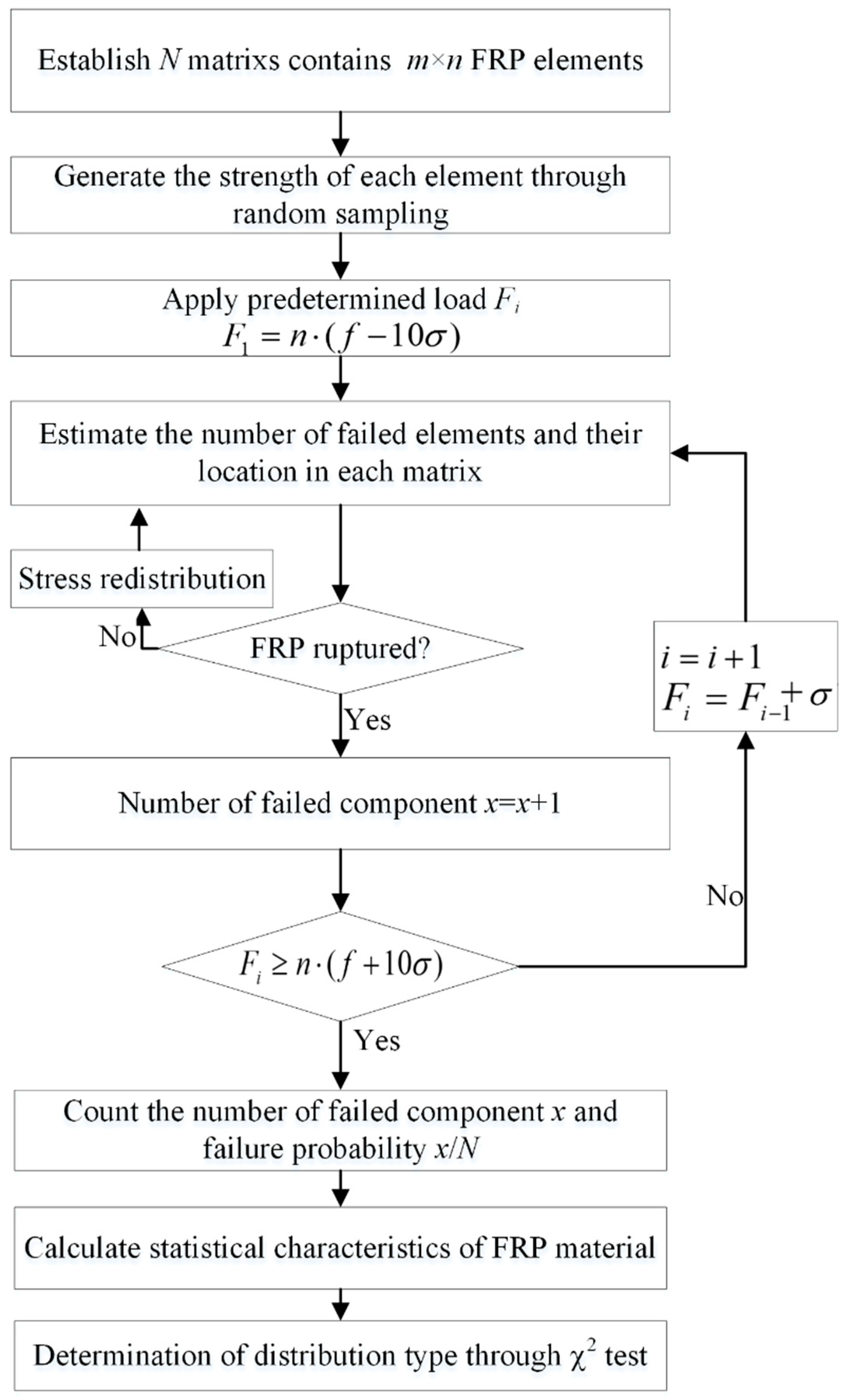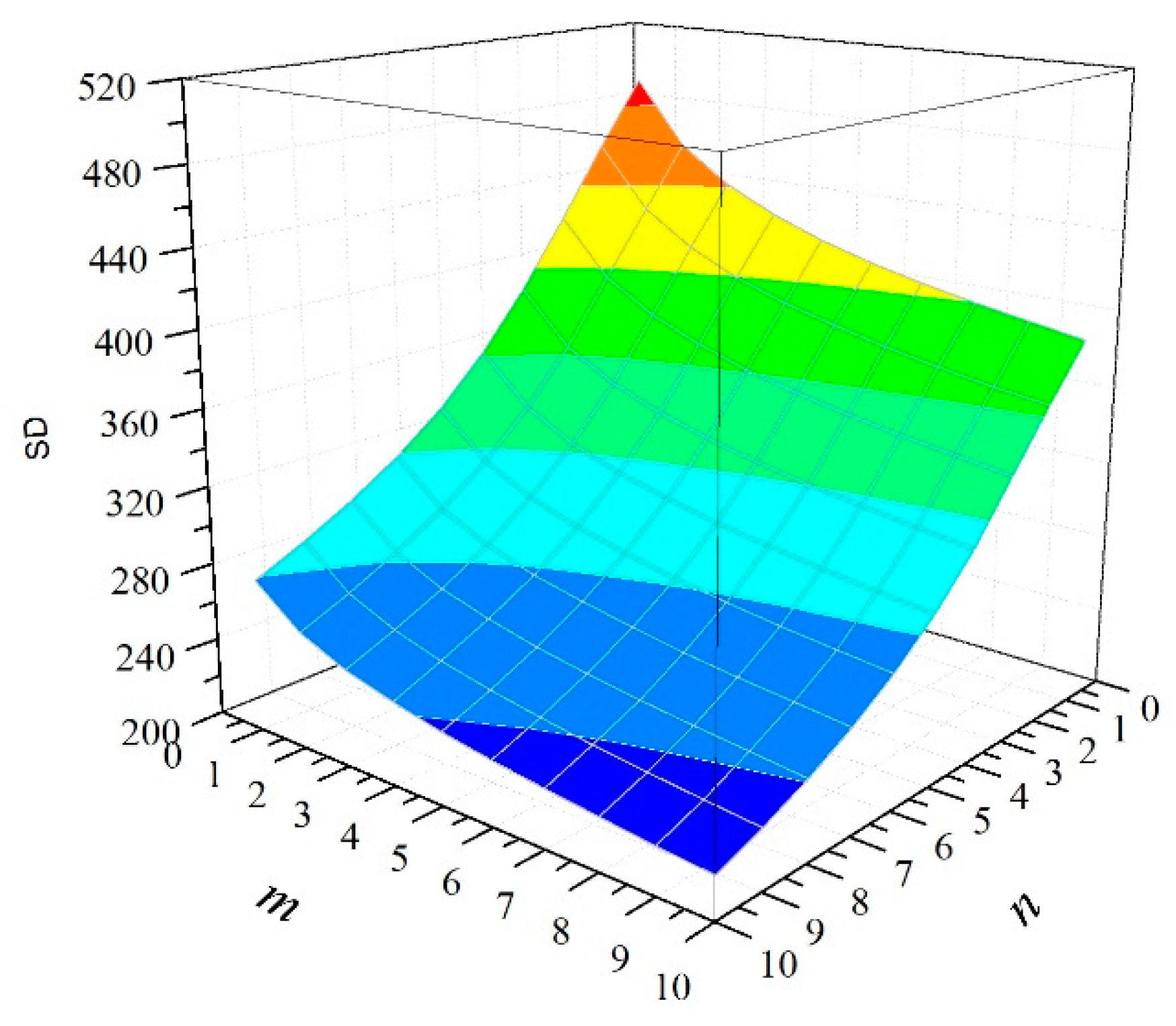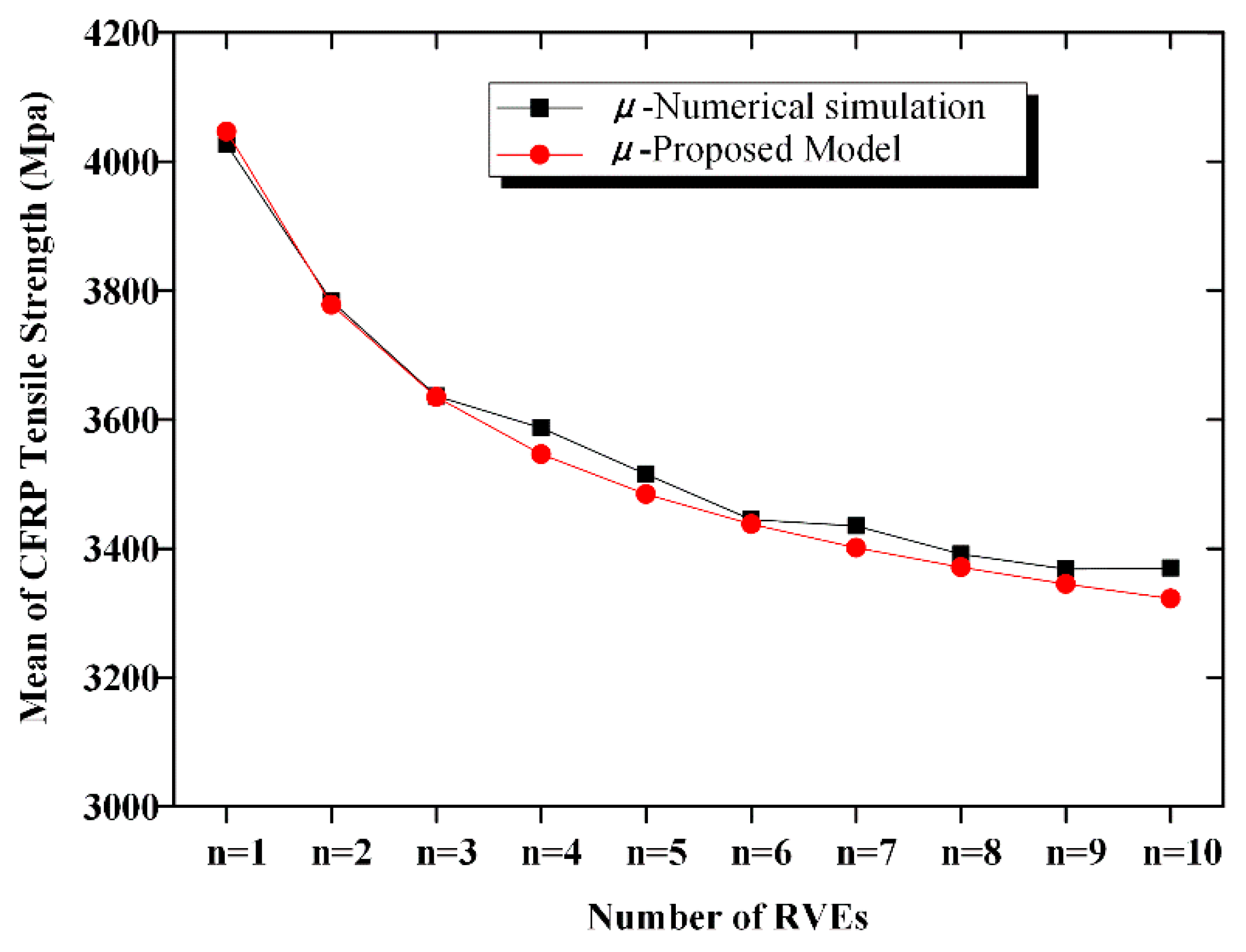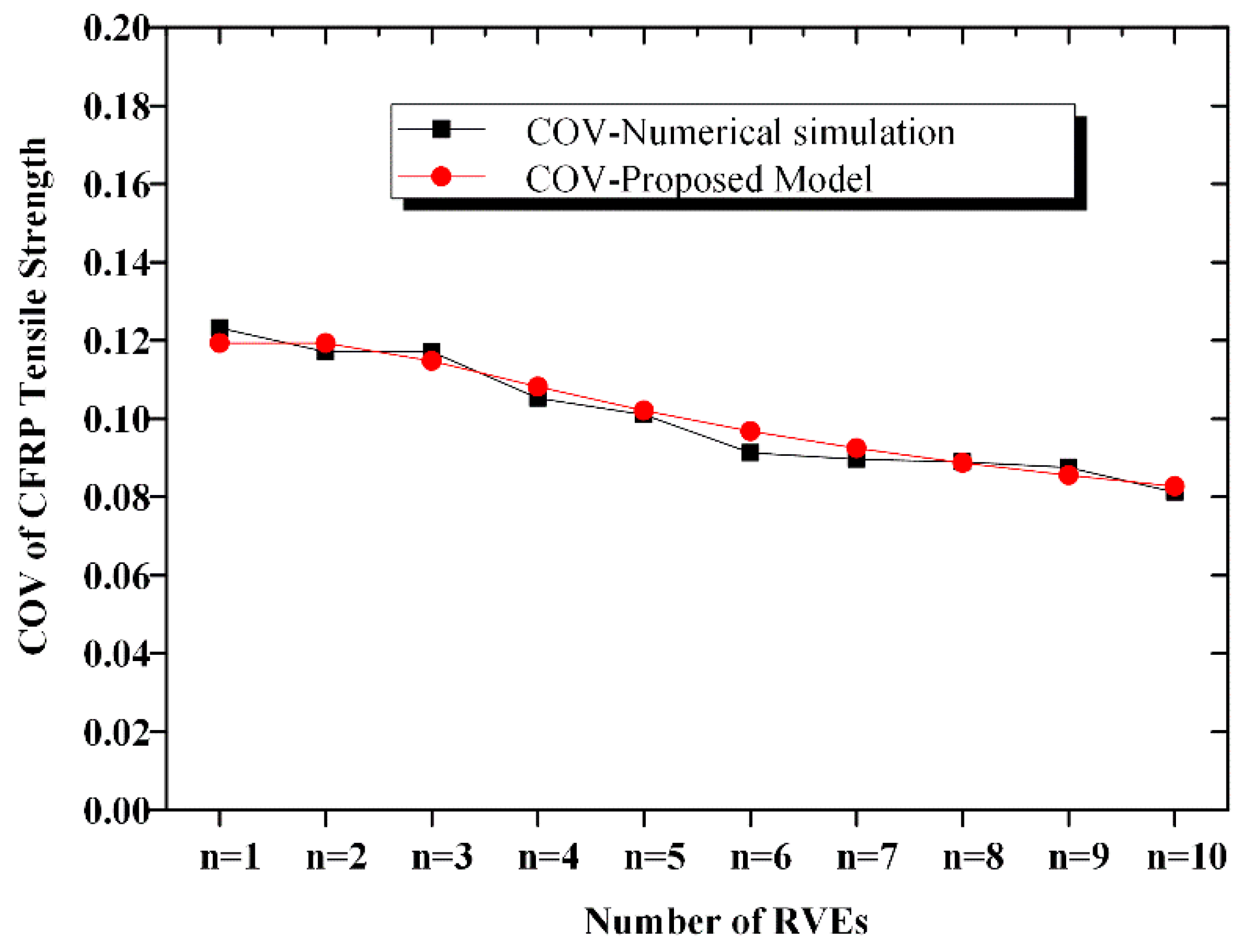Reliability Analysis of CFRP-Strengthened RC Bridges Considering Size Effect of CFRP
Abstract
:1. Introduction
2. Size Effect Model of CFRP
2.1. Mean CFRP Strength
2.2. COV of CFRP Strength
2.3. Distribution Type of CFRP Strength
3. Case Study
3.1. Project Overview
- (1)
- Crushing of the concrete in compression before yielding of the reinforcing steel;
- (2)
- Yielding of the steel in tension followed by rupture of the FRP laminate;
- (3)
- Yielding of the steel in tension followed by concrete crushing;
- (4)
- Shear/tension delamination of the concrete cover;
- (5)
- Debonding of the FRP from the concrete substrate.
- 1.
- Steel-yielding concrete crushing. In this mode, the tensile strain of the CFRP laminate is less than the allowable tensile strain when a failure occurrs. The flexural capacity of the strengthened RC beam can be expressed by equilibrium of the moment at the mid-span cross-section, as Equation (13) [31]:
- 2.
- Steel-yielding FRP rupture. In this mode, the concrete has not yet reached its ultimate capacity when the failure occurrs. This is the most common failure mode of a well-designed CFRP-strengthened RC beam. The flexural capacity of the strengthened RC beam can be expressed as Equation (15):
3.2. Performance Function
3.3. Reliability Evaluation of the CFRP-Strengthened Bridge
4. Conclusions
Author Contributions
Funding
Conflicts of Interest
Abbreviations
| FRP | fiber-reinforced plastic |
| CFRP | carbon fiber-reinforced plastic |
| GFRP | glass fiber-reinforced plastic |
| MC | Monte-Carlo |
| COV | coefficient of variation |
| RC | Reinforced concrete |
| RVE | representative volume element |
| CDF | cumulative distribution function |
| ELS | Equal Load Sharing |
| SD | standard deviation |
| probability density function | |
| FORM | first-order reliability method |
Symbols
| Pf,e(f) | is the failure probability of a link under stress f; |
| Pf,s(f) | is the failure probability of the chain; |
| N | is the number of links in the chain; |
| f | is the mean deviation of CFRP RVEs’ tensile strength; |
| is the standard deviation of CFRP RVEs’ tensile strength; | |
| xi | is the number of failed specimens under load ; |
| N | is the total number of virtual specimens; |
| is the failure probability of the system; | |
| e | is the failure probability of the element; |
| is the system reliability; | |
| is the failure probability of the components after stress redistribution; | |
| is the reliability of the components after stress redistribution; | |
| η | is the scale parameter; |
| β | is the shape parameter; |
| n | is the number of the parallel elements; |
| m | is the number of series elements; |
| fFRP | is the mean strength of the RVEs; |
| fc | is the 28-day yield strength of concrete; |
| b | is the width of the girder web; |
| x | is the height of the compression zone; |
| h0 | is the effective height of the girder cross section; |
| is the yield strength of compression reinforcement; | |
| is the yield strength of tension reinforcement; | |
| α | is the corrosion rate of the reinforcement; |
| as | is the thickness of the concrete cover; |
| Ef | is the elastic module of the CFRP laminate, |
| is the CFRP strain when the failure occurred; | |
| Af | is the sectional area of the CFRP laminate; |
| is the sectional area of compression reinforcement; | |
| is the sectional area of tension reinforcement; | |
| is the relative height of the compression zone during a CFRP rupture; | |
| is the ultimate strain in the FRP; | |
| is the model uncertainty factor for the flexural capacity of CFRP-strengthened RC beams; | |
| is the bending moment generated by permanent loads; | |
| is the bending moment generated by live loads; | |
| l | is the span length of the RC girder; |
| g1 | is the weight of the precast RC girder per unit length; |
| g2 | is the equivalent dead load of the RC diaphragm per unit length; |
| is the weight of the asphalt concrete pavement per unit length; | |
| λconc | is the uncertainty factor of the RC dead load; |
| λasph | is the uncertainty factor of the asphalt concrete dead load; |
| Ibeam | is the impact coefficient of the vehicle load; |
| ξ | is the girder distribution factor, c is the overload rate; |
| mcq | is the transverse distribution coefficient of the vehicle load; |
| is the uniform lane load; | |
| Pk | is the concentrated lane load; |
| mcr | is the transverse distribution coefficient of the crowd load; |
| is the crowd load; | |
| λmtrk-i | is the uncertainty factor of the moment generated by the live loads on the beam. |
| is the stress distribution function in compressive concrete; | |
| is the strain distribution function in compressive concrete; | |
| is the strain corresponding to ultimate strength of concrete; | |
| is the strain of concrete while failure occurs; c is the depth to the neutral axis; | |
| is the initial strain in the concrete before strengthened; | |
| is the initial moment; | |
| is the relative height of the compression zone of the cracked cross section; | |
| is elastic modulus of concrete; | |
| is the inertia moment of cracked cross section. |
References
- Günaydin, M.; Adanur, S.; Altunişik, A.; Sevim, B. Static and dynamic responses of Halgavor Footbridge using steel and FRP materials. Steel Compos. Struct. 2015, 18, 51–69. [Google Scholar] [CrossRef]
- Park, J.-W.; Yoo, J.-H. Flexural and compression behavior for steel structures strengthened with carbon fiber reinforced polymers (CFRPs) sheet. Steel Compos. Struct. 2015, 19, 441–465. [Google Scholar] [CrossRef]
- Plevris, N.; Triantafillou, T.C.; Veneziano, D. Reliability of RC members strengthened with CFRP laminates. J. Struct. Eng. 1995, 121, 1037–1044. [Google Scholar] [CrossRef]
- Okeil, A.M.; El-Tawil, S.; Shahawy, M. Flexural reliability of reinforced concrete bridge girders strengthened with carbon fiber-reinforced polymer laminates. J. Bridg. Eng. 2002, 7, 290–299. [Google Scholar] [CrossRef]
- Atadero, R.; Lee, L.; Karbhari, V.M. Consideration of material variability in reliability analysis of FRP strengthened bridge decks. Compos. Struct. 2005, 70, 430–443. [Google Scholar] [CrossRef]
- Zureick, A.-H.; Bennett, R.M.; Ellingwood, B.R. Statistical characterization of fiber-reinforced polymer composite material properties for structural design. J. Struct. Eng. 2006, 132, 1320–1327. [Google Scholar] [CrossRef]
- Zhou, J.; Bi, F.; Wang, Z.; Zhang, J. Experimental investigation of size effect on mechanical properties of carbon fiber reinforced polymer (CFRP) confined concrete circular specimens. Constr. Build. Mater. 2016, 127, 643–652. [Google Scholar] [CrossRef]
- Barbieri, G.; Biolzi, L.; Bocciarelli, M.; Cattaneo, S. Size and shape effect in the pull-out of FRP reinforcement from concrete. Compos. Struct. 2016, 143, 395–417. [Google Scholar] [CrossRef]
- Ben Dror, E.; Rabinovitch, O. Size effect in the debonding failure of FRP strengthened beams. Eng. Fract. Mech. 2016, 156, 161–181. [Google Scholar] [CrossRef]
- Mahmoud, K.; El-Salakawy, E. Size effect on shear strength of glass fiber-reinforced polymer-reinforced concrete continuous beams. ACI Struct. J. 2016, 113, 125. [Google Scholar] [CrossRef]
- Weibull, W. The Phenomenon of Rupture in Solids; (Ingenioersvetenskaps Akad. Handl.); Royal Swedish Institute of Engineering Research: Stockholm, Sweden, 1939; Volume 153, pp. 1–55. [Google Scholar]
- Bazant, Z.P.; Frangopol, D.M. Size effect hidden in excessive dead load factor. J. Struct. Eng. 2002, 128, 80–86. [Google Scholar] [CrossRef]
- Bazant, Z.P.; Novák, D. Probabilistic nonlocal theory for quasibrittle fracture initiation and size effect. I: Theory. J. Eng. Mech. 2000, 126, 166–174. [Google Scholar] [CrossRef]
- Bažant, Z.P.; Pang, S.D. Mechanics-based statistics of failure risk of quasibrittle structures and size effect on safety factors. Proc. Natl. Acad. Sci. USA 2006, 103, 9434–9439. [Google Scholar] [CrossRef] [Green Version]
- Bazant, Z.P.; Pang, S.-D. Activation energy based extreme value statistics and size effect in brittle and quasibrittle fracture. J. Mech. Phys. Solids 2007, 55, 91–131. [Google Scholar] [CrossRef]
- Le, J.L. Size effect on reliability indexes and safety factors of quasibrittle structures. Struct. Saf. 2015, 52, 20–28. [Google Scholar] [CrossRef]
- Lei, W.-S.; Su, P. An approach to scaling size effect on strength of quasi-brittle biomedical materials. J. Mech. Behav. Biomed. Mater. 2016, 62, 428–432. [Google Scholar] [CrossRef] [PubMed]
- Batdorf, S. Tensile strength of unidirectionally reinforced composites—I. J. Reinf. Plast. Compos. 1982, 1, 153–164. [Google Scholar] [CrossRef]
- Harlow, D.G.; Phoenix, S.L. The chain-of-bundles probability model for the strength of fibrous materials I: Analysis and conjectures. J. Compos. Mater. 1978, 12, 195–214. [Google Scholar] [CrossRef]
- Harlow, D.G.; Phoenix, S.L. Bounds on the probability of failure of composite materials. Int. J. Fract. 1979, 15, 321. [Google Scholar]
- Bergman, B. On the probability of failure in the chain-of-bundles model. J. Compos. Mater. 1981, 15, 92–98. [Google Scholar] [CrossRef]
- Ruggieri, C.; Minami, F.; Toyoda, M. A statistical approach for fracture of brittle materials based on the chain-of-bundles model. J. Appl. Mech. 1995, 62, 320–328. [Google Scholar] [CrossRef]
- Moshtaghin, A.F.; Franke, S.; Keller, T.; Vassilopoulos, A.P. Random field-based modeling of size effect on the longitudinal tensile strength of clear timber. Struct. Saf. 2016, 58, 60–68. [Google Scholar] [CrossRef] [Green Version]
- Bažant, Z.P.; Daniel, I.M.; Li, Z. Size Effect and fracture characteristics of composite laminates. J. Eng. Mater. Technol. 1996, 118, 317–324. [Google Scholar]
- Maimí, P.; González, E.V.; Gascons, N.; Ripoll, L. Size effect law and critical distance theories to predict the nominal strength of quasibrittle structures. Appl. Mech. Rev. 2013, 65, 020803. [Google Scholar] [CrossRef]
- Caner, F.C.; Bazant, Z.P. Size effect on strength of laminate-foam sandwich plates: Finite element analysis with interface fracture. Compos. Part B Eng. 2009, 40, 337–348. [Google Scholar] [CrossRef]
- Bažant, Z.P.; Zhou, Y.; Daniel, I.M.; Caner, F.C.; Yu, Q. Size effect on strength of laminate-foam sandwich plates. J. Eng. Mater. Technol. 2006, 128, 366–374. [Google Scholar] [CrossRef]
- Bazant Z, P. Probabilistic modeling of quasibrittle fracture and size effect. In Proc. 8th Int. Conf. on Structural Safety and Reliability (ICOSSAR); Swets and Zeitinger, Balkema: Boca Raton, FL, USA, 2001; pp. 1–23. [Google Scholar]
- Laffan, M.; Pinho, S.; Robinson, P.; Iannucci, L.; Pinho, S. Measurement of the in situ ply fracture toughness associated with mode I fibre tensile failure in FRP. Part II: Size and lay-up effects. Compos. Sci. Technol. 2010, 70, 614–621. [Google Scholar] [CrossRef]
- Okabe, T. Size effect on tensile strength of unidirectional CFRP composites—Experiment and simulation. Compos. Sci. Technol. 2002, 62, 2053–2064. [Google Scholar] [CrossRef]
- Ministry of Transport of the People’s Republic of China (MOT). JTG/T J22-2008, Specifications for Strengthening Design of Highway Bridges; China Communications Press: Beijing, China, 2008. (In Chinese)
- China State Bureau of Quality Technical Supervision (CSBTS). Test Method for Tensile Properties of Oriented Fiber Reinforced Plastics; GB/T 3354-1999; China Standards Press: Beijing, China, 1999. (In Chinese)
- Yue, Q.; Cao, J.; Yang, Y.; Zhan, Y. Normative specimen of carbon fiber reinforced polymer sheets for checking property. Ind. Construct. 2005, 35, 1–4. (In Chinese) [Google Scholar]
- Daniels, H.E. The statistical theory of the strength of bundles of threads. I. Proc. R. Soc. Lond. Ser. A. Math. Phys. Sci. 1945, 183, 405–435. [Google Scholar] [Green Version]
- Scop, P.M.; Argon, A.S. Statistical theory of strength of laminated composites II. J. Compos. Mater. 1969, 3, 30–47. [Google Scholar] [CrossRef]
- Turcotte, D.L.; Smalley, R.F.; Solla, S.A. Collapse of loaded fractal trees. Nature 1985, 313, 671–672. [Google Scholar] [CrossRef]
- Smalley, R.F.; Turcotte, D.L.; Solla, S.A. A renormalization group approach to the stick-slip behavior of faults. J. Geophys. Res. Space Phys. 1985, 90, 1894. [Google Scholar] [CrossRef]
- Ministry of Transport of the People’s Republic of China (MOT). JTG H11-2004 Code for Maintenance of Highway Bridges and Culvers; China Plan Press: Beijing, China, 2004. (In Chinese)
- American Concrete Institute (ACI). Guide for Design and Construction of Externally Bonded FRP Systems for Strengthening Concrete Structures; ACI 440.2R-08; ACI Committee: Farmington Hills, MI, USA, 2008; Volume 440. [Google Scholar]
- Ministry of Transport of the People’s Republic of China (MOT). GB/T 50283-1999 Unified Standard for the Reliability Design of Highway Engineering Structures; China Plan Press: Beijing, China, 1999. (In Chinese)


















| Statistical Characteristics | Mean (MPa) | COV | Distribution Type |
|---|---|---|---|
| Value | 4078 | 0.12 | Weibull’s distribution |
| m | n | (16-2-1) | Normal Distribution | Log-Normal Distribution | Weibull’s Distribution | Gamma Distribution |
|---|---|---|---|---|---|---|
| 1 | 1 | 29.819 | 3.450 | 8.599 | 3.368 | 4.400 |
| 2 | 1 | 29.819 | 9.200 | 15.326 | 3.766 | 11.615 |
| 3 | 1 | 29.819 | 6.097 | 9.519 | 4.081 | 8.396 |
| 4 | 1 | 29.819 | 9.892 | 13.070 | 7.251 | 11.684 |
| 5 | 1 | 29.819 | 11.219 | 14.616 | 7.295 | 12.863 |
| 6 | 1 | 29.819 | 9.236 | 12.792 | 5.531 | 11.287 |
| 7 | 1 | 29.819 | 8.987 | 9.544 | 12.003 | 9.368 |
| 8 | 1 | 29.819 | 14.790 | 14.281 | 24.031 | 14.394 |
| 9 | 1 | 29.819 | 14.349 | 12.158 | 33.040 | 12.845 |
| 10 | 1 | 29.819 | 6.466 | 7.619 | 6.974 | 6.867 |
| 1 | 2 | 29.819 | 4.027 | 6.265 | 4.708 | 5.273 |
| 1 | 3 | 29.819 | 7.315 | 12.884 | 2.717 | 9.794 |
| 1 | 4 | 29.819 | 12.472 | 16.008 | 9.961 | 14.372 |
| 1 | 5 | 29.819 | 10.716 | 16.062 | 5.845 | 13.210 |
| 1 | 6 | 29.819 | 15.178 | 25.477 | 6.651 | 23.487 |
| 1 | 7 | 29.819 | 2.854 | 1.651 | 16.599 | 1.898 |
| 1 | 8 | 29.819 | 27.733 | 33.521 | 24.190 | 30.065 |
| 1 | 9 | 29.819 | 11.805 | 19.860 | 6.321 | 14.722 |
| 1 | 10 | 29.819 | 16.747 | 21.015 | 13.123 | 18.953 |
| Variables | Bias | COV | Distribution Type |
|---|---|---|---|
| Model uncertainty factor of CFRP-strengthened RC beam in flexure γmfc | 1.0980 | 0.1190 | Normal |
| Yield stress of steel reinforcing fy | 1.0900 | 0.0606 | Normal |
| Reinforced steel area in concrete As | 1.0000 | 0.0350 | Normal |
| 28-day yield strength of concrete fc | 1.2510 | 0.1464 | Normal |
| Uncertainty factor: weight of concrete λconc | 0.9865 | 0.0980 | Normal |
| Uncertainty factor: weight of asphalt λasph | 0.9891 | 0.1114 | Normal |
| Impact on girders Ibeam | 1.0000 | 0.0500 | Gumbel |
| Uncertainty factor: live load moment on girder | 1.3500 | 0.162 | Gumbel |
| Width of cross section b | 1.0013 | 0.0081 | Normal |
| Height of cross section h0 | 1.0124 | 0.0229 | Normal |
| Design distribution of lane load qk | 0.7882 | 0.1082 | Gumbel |
| Crowd load qr | 0.5786 | 0.3911 | Gumbel |
| Tensile strength of CFRP laminates fFRP (size effect not considered) | 1.1900 | 0.1260 | Weibull |
| Tensile strength of CFRP laminates fFRP (size effect considered) | 0.7512 | 0.0805 | Weibull |
| Thickness of CFRP strips t | 0.8250 | 0.0400 | Normal |
| Elasticity modulus of CFRP laminates Ef | 1.1800 | 0.1040 | Normal |
| Existing Bridge | Reference Scheme | Reinforcement Scheme Considering Size Effect | |
|---|---|---|---|
| Reliability index | 4.1 | 5.4 | 5.0 |
| Failure probability | 2.07 × 10−5 | 3.33 × 10−8 | 2.87 × 10-7 |
© 2019 by the authors. Licensee MDPI, Basel, Switzerland. This article is an open access article distributed under the terms and conditions of the Creative Commons Attribution (CC BY) license (http://creativecommons.org/licenses/by/4.0/).
Share and Cite
Xie, H.-B.; Wang, Y.-F. Reliability Analysis of CFRP-Strengthened RC Bridges Considering Size Effect of CFRP. Materials 2019, 12, 2247. https://doi.org/10.3390/ma12142247
Xie H-B, Wang Y-F. Reliability Analysis of CFRP-Strengthened RC Bridges Considering Size Effect of CFRP. Materials. 2019; 12(14):2247. https://doi.org/10.3390/ma12142247
Chicago/Turabian StyleXie, Hui-Bing, and Yuan-Feng Wang. 2019. "Reliability Analysis of CFRP-Strengthened RC Bridges Considering Size Effect of CFRP" Materials 12, no. 14: 2247. https://doi.org/10.3390/ma12142247




